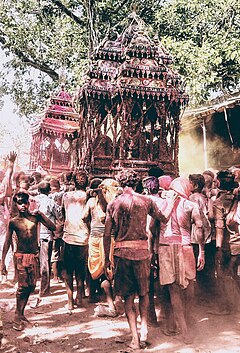Dol Purnima
| Dolo Purnima | |
|---|---|
 Krishna being carried in a procession in Odisha on Dola Purnima | |
| Also called | Dola Jatra |
| Observed by | Hindus of the Indian states/regions of Braj, Rajasthan, Gujarat, West Bengal, Odisha, Assam and Bangladesh |
| Type | Religious, cultural, spring festival |
| Celebrations | spraying coloured dye, playing with coloured powder, dancing, greetings, festival delicacies |
| Date | Phalguna Purnima |
| 2024 date | 25 March in India |
| Frequency | Annual |
| Related to | Holi |
Dola Purnima, also popularly known as Dolo Jatra, Doul Utsav or Deul, is a Hindu swing festival celebrated during the Holi festival of Braj region, Rajasthan, Gujarat,[1] Odisha, Assam, Tripura and Bengal region.[2][3] This festival is dedicated to the divine couple of Radha and Krishna. It is usually celebrated on the full moon night or fifteenth day of the Falgun month mainly by Gopal community.[4]
Etymology and references in literature
[edit]Hindu literature is replete with references of terms like Dolotsava and Dola Yatra. Shri Garga Samhita, a Vaishnav text has reference to Dolotsava of Shri Krishna in the month of Chaitra.[5]
The Sanskrit word Dola means a swing,[6] while utsava means a festival or a feast. Hence, Dolotsava literally means swing festival or swing feast and refers to religious service of swinging the idol of a deity on a swing.[7]
Similarly, word Dola Yatra is compound of two Sanskrit words: Dola and yatra . Yatra refers to procession and thus Dola yatra refers to swing procession.[8]
Significance
[edit]Radha Vallabha Sampradaya
[edit]This festival is also celebrated with great fervor and enthusiasm in Radha Vallabh Sampradaya and Haridasi Sampradaya where the idols of Radha Krishna are worshipped and offered colours and flowers to commence the festivities.[9]
Gaudiya Vaishnavism
[edit]In Gaudiya Vaishnavism, this festival is further more significant as it was the day when Chaitanya Mahaprabhu was born who was also worshipped as the combined avatar of Radha and Krishna. He was a great saint and a philosopher who played an important part in flourishing the Bhakti movement in India. He was also the founder of Gaudiya Vaishnavism tradition.[citation needed]
Celebration
[edit]On this auspicious day, the murtis of Krishna and his beloved Radha, richly adorned and besmeared with colored powder. In Braj, Rajasthan, Gujarat, Bengal, Odisha and Assam, the murtis of Radha Krishna are taken out in procession in a swinging palanquin, decorated with flowers, leaves, colored clothes and papers.[10] The procession proceeds forward to the accompaniment of music, blaring of conch shells, trumpets horn and shouts of joy or victory and 'Hôri Bola'.
In the region of Assam, the festival is marked by singing songs, like "Phaku khele korunamoy" by the 16th Century Assamese poet Madhavdev, especially at the Barpeta Satra.[11] The 15th century saint, artist and social reformer Srimanta Sankardev celebrated Doul at Bordowa in Nagaon, Assam.[12] The festival also includes playing with colours made usually from flowers traditionally.
In South India, the kirtan compositions of the 15th century poet, Annamacharya and Tyagaraja are sung in the evening.[13] Dolotsavam is celebrated on Holika Purnima at Suryanarayan Swamy temple at Arasavalli, Andhra Pradesh.[14]
See also
[edit]Bibliography
[edit]- Verma, Vanish (2002). Fasts and Festivals of India. New Delhi: Diamond Pocket Books.
References
[edit]- ^ Irshad (2023-03-06). "Special arrangements were made by the temple for the darshan of Ranchodraiji in Dakor Pipa News - PiPa News". Retrieved 2023-10-25.
- ^ Das, Priyaranjan (8 March 2012). "Borpetar Mormadhor Deul". Gono Odhikar Xongbad Potro.
- ^ "Holi | Definition, Holiday, Story, & Facts | Britannica". www.britannica.com. Retrieved 2023-04-26.
- ^ "www.gopabandhuacademy.gov.in" (PDF).
- ^ Goswami, Danavir (16 July 2022). "Garga Samhita (English)". wisdomlib.org.
- ^ www.wisdomlib.org (2009-04-11). "Dola, Dolā, Ḍola: 23 definitions". www.wisdomlib.org. Retrieved 2023-10-26.
- ^ www.wisdomlib.org (2020-04-10). "Dolotsava: 4 definitions". www.wisdomlib.org. Retrieved 2023-10-26.
- ^ www.wisdomlib.org (2020-02-04). "Dola-yatra, Dola-yātrā, Dolayatra: 5 definitions". www.wisdomlib.org. Retrieved 2023-10-26.
- ^ "Dolotsav of Shri Radhavallabh Lal". Braj Ras - Bliss of Braj Vrindavan. Retrieved 2023-10-26.
- ^ "Holi (Phalguna-purnima or Dol-purnima)". Archived from the original on 2013-03-21. Retrieved 2012-05-07.
- ^ Karmakar, Rahul (21 March 2019). "Where Holi is 'sung,' not merely played". The Hindu. Retrieved 22 May 2021.
- ^ Huzuri, Dhaneswar. "Doul Utsow Aru Iyar Tatporzyo". Vikaspedia. Archived from the original on 2018-04-05. Retrieved 22 May 2021.
- ^ Wicks, Yasmina (2018-11-26). Profiling Death. Neo-Elamite Mortuary Practices, Afterlife Beliefs, and Entanglements with Ancestors. BRILL. p. 40. ISBN 978-90-04-39177-2.
- ^ "dolostavams festival in arasavalli,Utasavams in arasavalli,Dolotsavam". www.arasavallisungod.org. Retrieved 2023-10-26.
Dolostavams Festival in Arasavalli This Ritual is otherwise known as Holika Pournima or Holi. This comes in the month of March
External links
[edit]- Bhatt,S. C., Bhargava, Gopal K. (2006) Land and People of Indian States and Union Territories In 36 Volumes. Orissa · Volume 21 . Kalpaz
